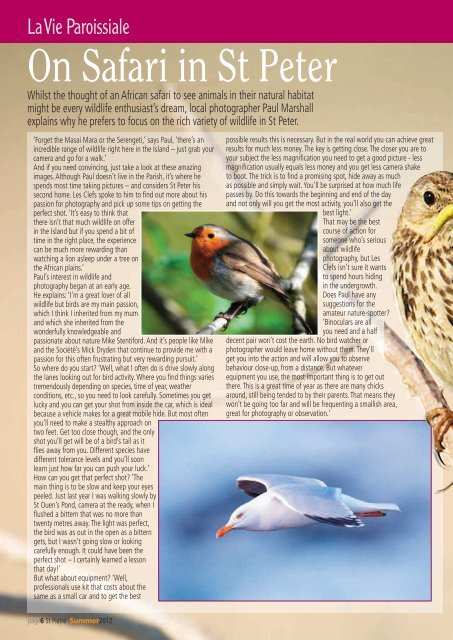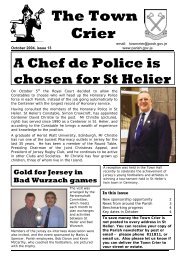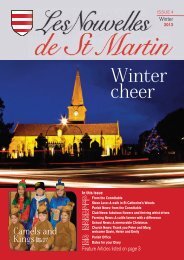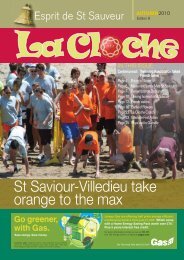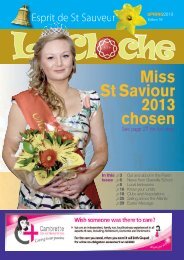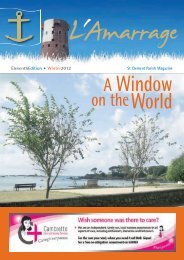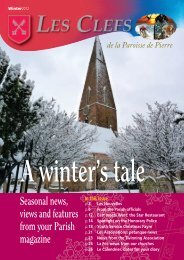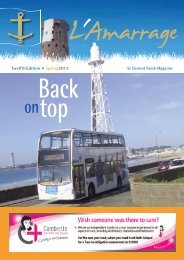Les Clefs de la Paroisse de St Pierre 04/09/2012 - Parishes Online
Les Clefs de la Paroisse de St Pierre 04/09/2012 - Parishes Online
Les Clefs de la Paroisse de St Pierre 04/09/2012 - Parishes Online
Create successful ePaper yourself
Turn your PDF publications into a flip-book with our unique Google optimized e-Paper software.
La Vie Paroissiale<br />
On Safari in <strong>St</strong> Peter<br />
Whilst the thought of an African safari to see animals in their natural habitat<br />
might be every wildlife enthusiast’s dream, local photographer Paul Marshall<br />
exp<strong>la</strong>ins why he prefers to focus on the rich variety of wildlife in <strong>St</strong> Peter.<br />
‘Forget the Masai Mara or the Serengeti,’ says Paul, ‘there’s an<br />
incredible range of wildlife right here in the Is<strong>la</strong>nd – just grab your<br />
camera and go for a walk.’<br />
And if you need convincing, just take a look at these amazing<br />
images. Although Paul doesn’t live in the Parish, it’s where he<br />
spends most time taking pictures – and consi<strong>de</strong>rs <strong>St</strong> Peter his<br />
second home. <strong>Les</strong> <strong>Clefs</strong> spoke to him to find out more about his<br />
passion for photography and pick up some tips on getting the<br />
perfect shot. ‘It’s easy to think that<br />
there isn’t that much wildlife on offer<br />
in the Is<strong>la</strong>nd but if you spend a bit of<br />
time in the right p<strong>la</strong>ce, the experience<br />
can be much more rewarding than<br />
watching a lion asleep un<strong>de</strong>r a tree on<br />
the African p<strong>la</strong>ins.’<br />
Paul’s interest in wildlife and<br />
photography began at an early age.<br />
He exp<strong>la</strong>ins: ‘I’m a great lover of all<br />
wildlife but birds are my main passion,<br />
which I think I inherited from my mum<br />
and which she inherited from the<br />
won<strong>de</strong>rfully knowledgeable and<br />
passionate about nature Mike <strong>St</strong>entiford. And it’s people like Mike<br />
and the Société’s Mick Dry<strong>de</strong>n that continue to provi<strong>de</strong> me with a<br />
passion for this often frustrating but very rewarding pursuit.’<br />
So where do you start? ‘Well, what I often do is drive slowly along<br />
the <strong>la</strong>nes looking out for bird activity. Where you find things varies<br />
tremendously <strong>de</strong>pending on species, time of year, weather<br />
conditions, etc., so you need to look carefully. Sometimes you get<br />
lucky and you can get your shot from insi<strong>de</strong> the car, which is i<strong>de</strong>al<br />
because a vehicle makes for a great mobile hi<strong>de</strong>. But most often<br />
you’ll need to make a stealthy approach on<br />
two feet. Get too close though, and the only<br />
shot you’ll get will be of a bird’s tail as it<br />
flies away from you. Different species have<br />
different tolerance levels and you’ll soon<br />
learn just how far you can push your luck.’<br />
How can you get that perfect shot? ‘The<br />
main thing is to be slow and keep your eyes<br />
peeled. Just <strong>la</strong>st year I was walking slowly by<br />
<strong>St</strong> Ouen’s Pond, camera at the ready, when I<br />
flushed a bittern that was no more than<br />
twenty metres away. The light was perfect,<br />
the bird was as out in the open as a bittern<br />
gets, but I wasn’t going slow or looking<br />
carefully enough. It could have been the<br />
perfect shot – I certainly learned a lesson<br />
that day!’<br />
But what about equipment? ‘Well,<br />
professionals use kit that costs about the<br />
same as a small car and to get the best<br />
possible results this is necessary. But in the real world you can achieve great<br />
results for much less money. The key is getting close. The closer you are to<br />
your subject the less magnification you need to get a good picture - less<br />
magnification usually equals less money and you get less camera shake<br />
to boot. The trick is to find a promising spot, hi<strong>de</strong> away as much<br />
as possible and simply wait. You’ll be surprised at how much life<br />
passes by. Do this towards the beginning and end of the day<br />
and not only will you get the most activity, you’ll also get the<br />
best light.’<br />
That may be the best<br />
course of action for<br />
someone who’s serious<br />
about wildlife<br />
photography, but <strong>Les</strong><br />
<strong>Clefs</strong> isn’t sure it wants<br />
to spend hours hiding<br />
in the un<strong>de</strong>rgrowth.<br />
Does Paul have any<br />
suggestions for the<br />
amateur nature-spotter?<br />
‘Binocu<strong>la</strong>rs are all<br />
you need and a half<br />
<strong>de</strong>cent pair won’t cost the earth. No bird watcher or<br />
photographer would leave home without them. They’ll<br />
get you into the action and will allow you to observe<br />
behaviour close-up, from a distance. But whatever<br />
equipment you use, the most important thing is to get out<br />
there. This is a great time of year as there are many chicks<br />
around, still being ten<strong>de</strong>d to by their parents. That means they<br />
won’t be going too far and will be frequenting a smallish area,<br />
great for photography or observation.’<br />
page6 <strong>St</strong> <strong>Pierre</strong> Summer<strong>2012</strong>


